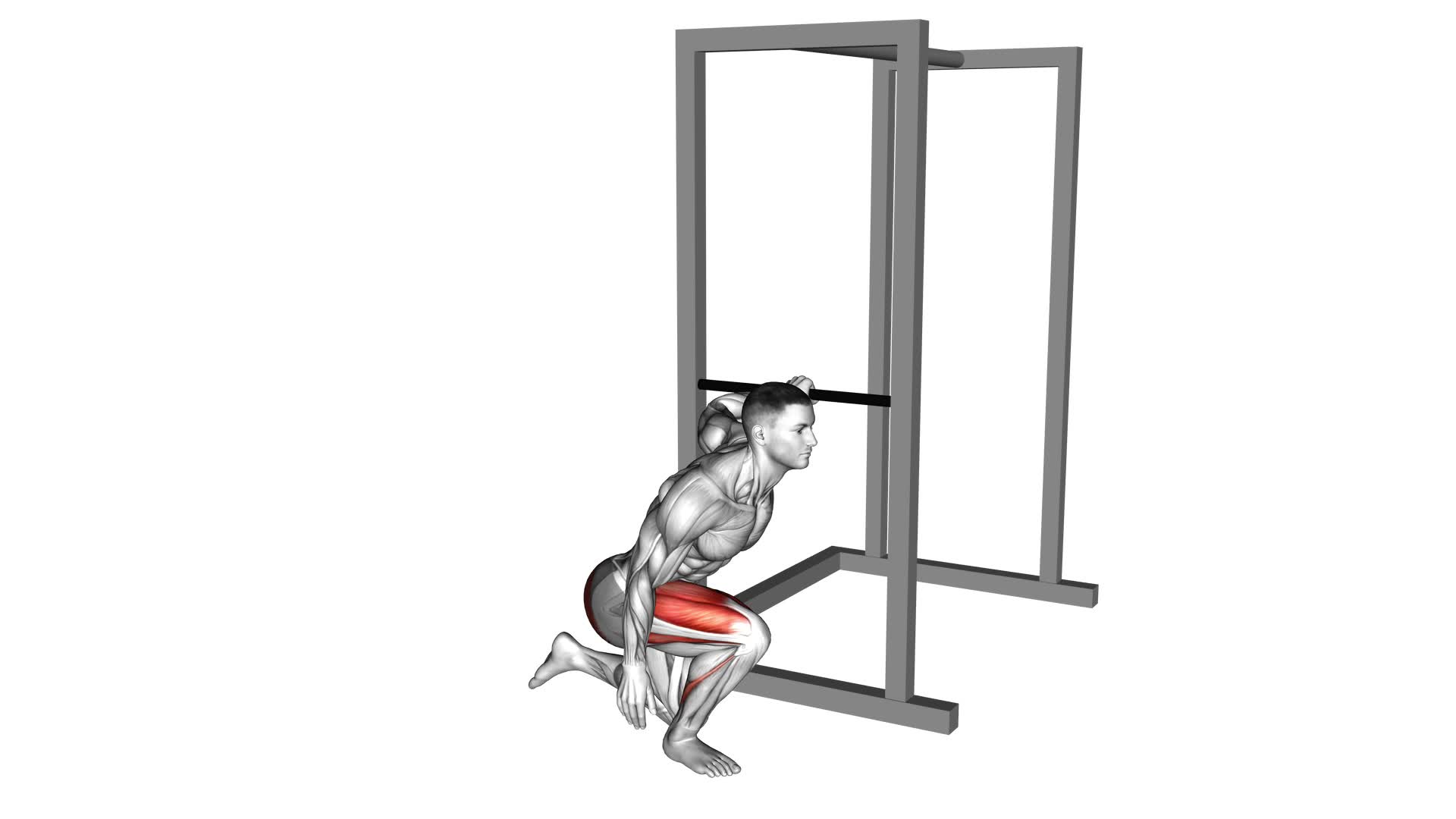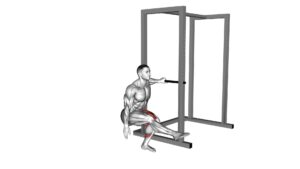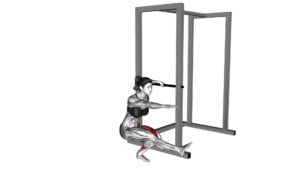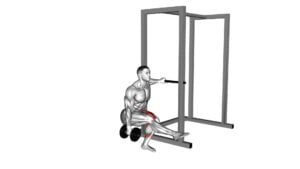Bodyweight Single Leg Squat With Support (Male) – Video Exercise Guide & Tips

Are you looking to strengthen your legs and improve your balance? Then the bodyweight single leg squat with support is the perfect exercise for you!
Watch This Exercise Video
In this video exercise guide, we'll show you the proper form and technique to perform this exercise effectively.
With just your bodyweight and a support, you can target your quads, glutes, and hamstrings.
Whether you're a beginner or looking to challenge yourself, we've got you covered with modifications and tips to increase intensity.
Let's get started!
Key Takeaways
- Improves balance
- Targets quads, glutes, and hamstrings
- Increases leg strength and tone
- Beneficial for athletes
Benefits of Bodyweight Single Leg Squat
You can experience numerous benefits from incorporating bodyweight single leg squats into your fitness routine. One of the main advantages is the improvement in balance that comes from performing this exercise. By standing on one leg and lowering yourself down, you're challenging your body to maintain stability and control. This can help to enhance your overall balance, which is essential for activities such as walking, running, and even everyday tasks like climbing stairs or carrying groceries.
In addition to improving balance, bodyweight single leg squats are also great for strengthening your leg muscles. The focus on one leg at a time means that you're really targeting the muscles in your thighs, hamstrings, and glutes. As you lower yourself down and push back up, these muscles are activated and engaged, leading to increased strength and tone. This can be particularly beneficial for athletes who rely on lower body strength, such as runners, cyclists, and soccer players.
To get the most out of bodyweight single leg squats, it's important to ensure proper form and technique. Transitioning into the subsequent section, we'll discuss the correct way to perform this exercise to maximize its benefits and minimize the risk of injury.
Proper Form and Technique
To ensure proper form and technique for the bodyweight single leg squat with support (male), it's important to understand the key elements of this exercise. Maintaining balance is crucial during this exercise, so here are a few tips to help you stay steady.
First, find a support, such as a chair or wall, to hold onto for stability.
Next, keep your core engaged and your chest lifted throughout the movement. This will help you maintain proper alignment and prevent any unnecessary strain on your lower back.
Additionally, focus on keeping your knee in line with your toes as you lower down into the squat position. This will ensure proper muscle activation and prevent any potential knee pain or injury.
As you descend, aim to lower your hips parallel to the ground, or as close as you can comfortably go.
Remember to control the movement and avoid any sudden or jerky motions.
Equipment Needed for This Exercise
To properly perform the bodyweight single leg squat with support (male) exercise, you'll need the following equipment. First and foremost, you'll need a stable support to hold onto during the exercise. This can be a sturdy chair, a railing, or even a wall-mounted bar. The support will help you maintain balance and stability as you perform the exercise.
In addition to the support, you may also want to consider using a mat or cushion to provide some extra comfort and support for your feet. This can be especially helpful if you have sensitive knees or ankles.
As for variations for the advanced level, there are a few options you can explore. One option is to add weights to the exercise by holding dumbbells or kettlebells in your hands. This will increase the resistance and make the exercise more challenging.
Another variation is to perform the exercise on an unstable surface, such as a balance board or a foam pad. This will require your muscles to work harder to maintain balance and stability, adding an extra challenge to the exercise.
Common Mistakes to Avoid
One common mistake to avoid when performing the bodyweight single leg squat with support (male) exercise is rushing through the movement without maintaining proper form and control. It's important to take your time and focus on each rep to ensure that you're engaging the correct muscles and maximizing the benefits of the exercise.
Another common mistake isn't using the support properly. The support is there to assist you in maintaining balance and stability, so make sure that you're using it as intended. Avoid leaning too heavily on the support or relying on it too much, as this can take away from the effectiveness of the exercise.
Additionally, be aware of your knee alignment. It's crucial to keep your knee in line with your toes throughout the movement to prevent any unnecessary strain or injury.
Lastly, avoid neglecting progression options. As you become more comfortable with the exercise, you can challenge yourself by increasing the range of motion or adding resistance. Progression is key to continuously improving and getting the most out of your workouts.
Modifications for Beginners
To help beginners with the bodyweight single leg squat, there are several modifications you can try.
First, you can use a chair for assistance by lightly touching it for balance as you squat down.
Another option is the wall support technique, where you lean against a wall for stability.
Lastly, you can start with half range variations, gradually increasing the depth of your squat as you build strength and confidence.
These modifications will allow you to gradually progress and improve your form without overwhelming your muscles.
Chair Assistance Option
Start by placing a chair behind you for support during the bodyweight single leg squat exercise. This modification is perfect for beginners who may need some assistance in maintaining balance and stability. Here are two reasons why using a chair can be beneficial:
- Stability: Having a chair nearby provides a stable support system, allowing you to focus on the proper form and technique without worrying about falling or losing your balance.
- Confidence: Using a chair gives beginners the confidence to try the bodyweight single leg squat, knowing that they've a stable surface to hold onto if needed.
By incorporating chair modifications into your workout routine, you can gradually build strength and stability, eventually progressing to the full exercise without any assistance.
Now, let's move on to the next section and discuss the wall support technique for the bodyweight single leg squat.
Wall Support Technique
Now let's explore another modification for beginners to the bodyweight single leg squat exercise: the wall support technique.
This technique provides additional support and stability for those who may find it challenging to perform the exercise without assistance.
To perform the wall support modification, stand facing a wall and extend one leg forward while keeping the other leg planted firmly on the ground.
Place your hands on the wall for support and slowly lower yourself into a squat position, focusing on maintaining proper form and balance.
As you become more comfortable with this modification, you can gradually decrease the amount of support from the wall until you can perform the exercise without assistance.
This modification is a great stepping stone towards more advanced variations of the bodyweight single leg squat.
Half Range Variations
As a beginner looking for modifications to the bodyweight single leg squat exercise, you can try half range variations. These variations are a great way to gradually build strength and stability in your legs while still challenging yourself.
Here are two sub-lists of half range variations that can help you progress from beginner to more advanced levels:
Variations to decrease difficulty:
- Perform the exercise with a higher support, such as using a chair or bench.
- Reduce the depth of the squat by only going halfway down and then coming back up.
Variations to increase difficulty:
- Increase the range of motion by going lower in the squat.
- Add weight by holding a dumbbell or kettlebell while performing the exercise.
Tips to Increase Intensity and Challenge
To increase the intensity and challenge of the bodyweight single leg squat with support exercise, consider incorporating additional resistance. There are several ways to progress and add difficulty to this exercise.
One option is to hold dumbbells or kettlebells in your hands while performing the squat. This will increase the load on your muscles and make the exercise more challenging.
Another way to increase the intensity is to use resistance bands. Attach the bands to a stable anchor point and then loop them around your shoulders or hold them in your hands. As you perform the squat, the bands will provide additional resistance, forcing your muscles to work harder.
You can also try performing the single leg squat on an unstable surface, such as a Bosu ball or a balance board. This will engage your core muscles even more as they work to stabilize your body during the exercise.
Lastly, you can progress to more advanced variations of the single leg squat, such as the pistol squat. This exercise requires greater balance and strength, as you lower down into a squat on one leg without the support of a bench or chair.
Incorporating these tips and variations will help you increase the intensity and challenge of the bodyweight single leg squat with support exercise, allowing you to continue making progress and improving your lower body strength.
Frequently Asked Questions
How Long Does It Take to See Results From Doing Bodyweight Single Leg Squats?
When it comes to seeing results from bodyweight single leg squats, it varies from person to person. Consistency and proper form are key.
Focus on progressing gradually by increasing the difficulty, such as reducing the support or adding weights. Avoid common mistakes like rushing through the exercise or neglecting proper balance.
With dedication and patience, you can start noticing improvements in strength, balance, and muscle definition. Stick to your routine and the results will come.
Can Bodyweight Single Leg Squats Help Improve Balance and Stability?
Bodyweight single leg squats are a great exercise for improving balance and stability. By focusing on one leg at a time, you challenge your body in a new way, which can lead to improved athleticism.
The benefits of unilateral training extend beyond just balance. It can also help to correct muscle imbalances and improve overall strength.
Incorporating bodyweight single leg squats into your workout routine can be a valuable addition for enhancing your physical performance.
Are Bodyweight Single Leg Squats Safe for People With Knee or Hip Injuries?
Bodyweight single leg squats can be a great exercise for improving balance and stability. However, if you have knee or hip injuries, it's important to take precautions.
While they can be safe for some people with injuries, it's best to consult with a healthcare professional or physical therapist to determine if they're appropriate for you. They may recommend modifications for beginners or suggest alternative exercises to prevent further injury.
Can Bodyweight Single Leg Squats Be Done as a Warm-Up Exercise Before Weightlifting?
Bodyweight single leg squats can definitely be done as a warm-up exercise before weightlifting. They offer several benefits, such as improving balance, stability, and leg strength. Plus, they engage your core muscles and help with overall body control.
There are also variations of bodyweight single leg squats that you can try to make the exercise more challenging or target specific muscles. So, incorporating them into your warm-up routine can be a great way to prepare your body for weightlifting.
How Often Should Bodyweight Single Leg Squats Be Incorporated Into a Workout Routine for Optimal Results?
To get optimal results, incorporate single leg squats into your workout routine regularly. These squats are great for building lower body strength and improving balance.
By including them in your workouts, you can target muscles that are often neglected in traditional squats. Aim to do them at least two to three times a week, but listen to your body and adjust based on your fitness level and recovery.
Consistency is key for reaping the benefits of single leg squats.
Conclusion
In conclusion, the bodyweight single leg squat with support is a highly beneficial exercise for building strength and stability in the lower body. By maintaining proper form and technique, using the necessary equipment, and avoiding common mistakes, individuals can maximize the benefits of this exercise.
Beginners can also modify the exercise to suit their fitness level, while advanced individuals can increase intensity and challenge themselves.
Incorporating this exercise into your routine can help improve overall leg strength and balance.

Author
Years ago, the spark of my life’s passion ignited in my mind the moment I stepped into the local gym for the first time. The inaugural bead of perspiration, the initial endeavor, the very first surge of endorphins, and a sense of pride that washed over me post-workout marked the beginning of my deep-seated interest in strength sports, fitness, and sports nutrition. This very curiosity blossomed rapidly into a profound fascination, propelling me to earn a Master’s degree in Physical Education from the Academy of Physical Education in Krakow, followed by a Sports Manager diploma from the Jagiellonian University. My journey of growth led me to gain more specialized qualifications, such as being a certified personal trainer with a focus on sports dietetics, a lifeguard, and an instructor for wellness and corrective gymnastics. Theoretical knowledge paired seamlessly with practical experience, reinforcing my belief that the transformation of individuals under my guidance was also a reflection of my personal growth. This belief holds true even today. Each day, I strive to push the boundaries and explore new realms. These realms gently elevate me to greater heights. The unique combination of passion for my field and the continuous quest for growth fuels my drive to break new ground.







